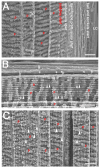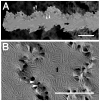The molecular mechanisms underlying lens fiber elongation
- PMID: 27015931
- PMCID: PMC5035171
- DOI: 10.1016/j.exer.2016.03.016
The molecular mechanisms underlying lens fiber elongation
Abstract
Lens fiber cells are highly elongated cells with complex membrane morphologies that are critical for the transparency of the ocular lens. Investigations into the molecular mechanisms underlying lens fiber cell elongation were first reported in the 1960s, however, our understanding of the process is still poor nearly 50 years later. This review summarizes what is currently hypothesized about the regulation of lens fiber cell elongation along with the available experimental evidence, and how this information relates to what is known about the regulation of cell shape/elongation in other cell types, particularly neurons.
Keywords: Actin; Cell shape; Cytoskeleton; Differentiation; Tubulin.
Copyright © 2016 Elsevier Ltd. All rights reserved.
Figures





References
-
- Alizadeh A, Clark JI, Seeberger T, Hess J, Blankenship T, Spicer A, FitzGerald PG. Targeted genomic deletion of the lens-specific intermediate filament protein CP49. Invest Ophthalmol Vis Sci. 2002;43:3722–7. - PubMed
Publication types
MeSH terms
Substances
Grants and funding
LinkOut - more resources
Full Text Sources
Other Literature Sources

